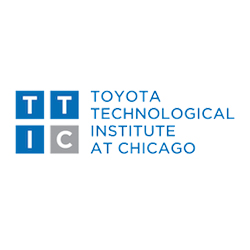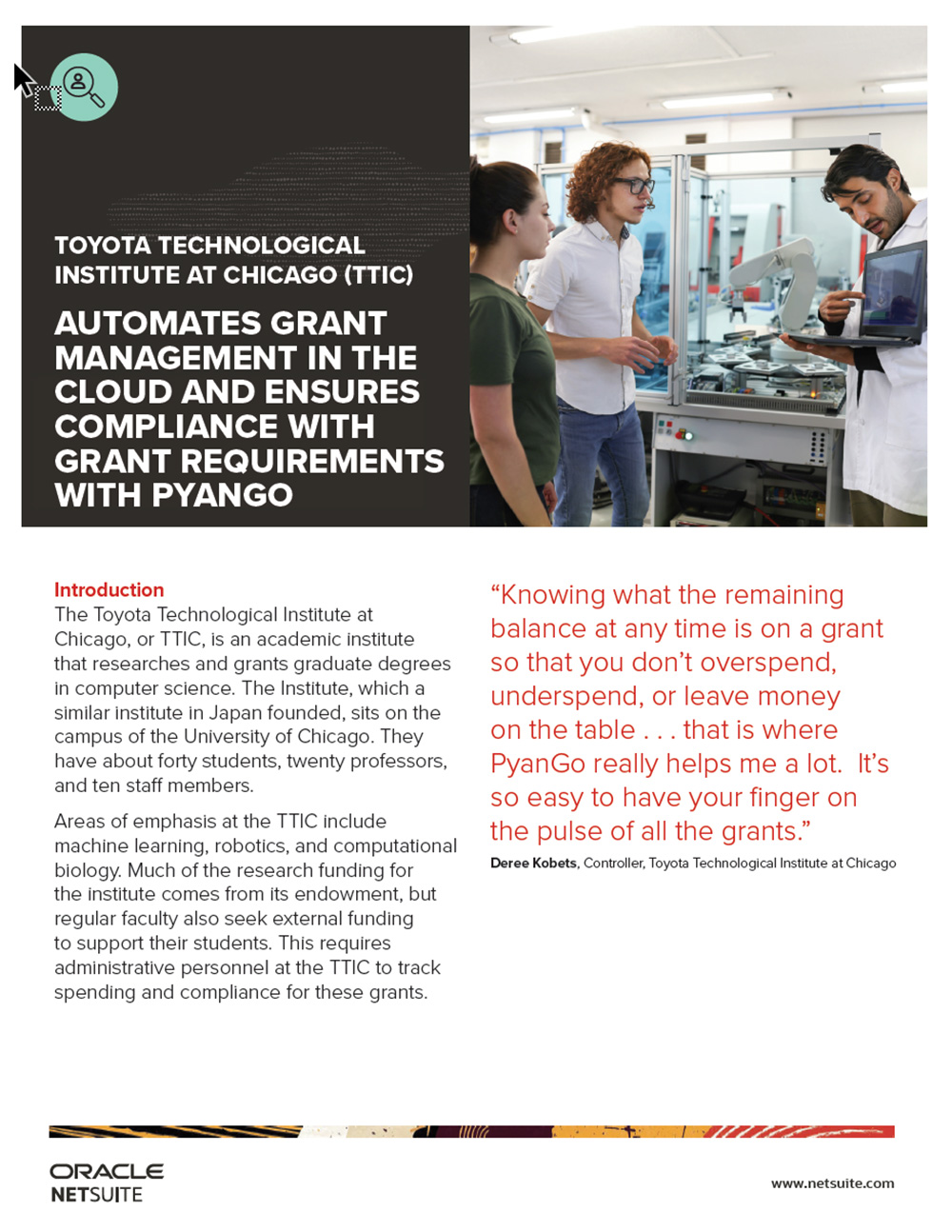Case Study: Toyota Technological Institute at Chicago (TTIC)
TTIC automates grant management in the cloud and ensures compliance with grant requirements with PyanGo
By: Rich Uphus | September 23, 2022
Introduction
The Toyota Technological Institute at Chicago, or TTIC, is an academic institute that researches and grants graduate degrees in computer science. The Institute, which a similar institute in Japan founded, sits on the campus of the University of Chicago. They have about forty students, twenty professors, and ten staff members.
The Toyota Technological Institute at Chicago, or TTIC, is an academic institute that researches and grants graduate degrees in computer science. The Institute, which a similar institute in Japan founded, sits on the campus of the University of Chicago. They have about forty students, twenty professors, and ten staff members.
Areas of emphasis at the TTIC include machine learning, robotics, and computational biology. Much of the research funding for the Institute comes from its endowment, but regular faculty also seek external funding to support their students. This requires administrative personnel at the TTIC to track spending and compliance for these grants.
“Knowing what the remaining balance at any time is on a grant so that you don’t overspend, underspend, or leave money on the table . . . that is where PyanGo really helps me a lot. It’s so easy to have your finger on the pulse of all the grants.”
– Deree Kobets, Controller, Toyota Technological Institute at Chicago
Challenge
When Deree Kobets started as the controller at TTIC, the first thing she wanted to do was move from their old paper-based accounting system into one that was paperless. “Especially in nonprofits,” she says, “there’s a lot of paper; there’s a lot of manual processes.”
When Deree Kobets started as the controller at TTIC, the first thing she wanted to do was move from their old paper-based accounting system into one that was paperless. “Especially in nonprofits,” she says, “there’s a lot of paper; there’s a lot of manual processes.”
She also wanted to switch to a cloud-based system. “With cloud-based software, you can access it easier; there’s more real-time collaboration between the people in finance and accounting, along with others submitting, for example, invoices and expense reports.”
With that in mind, TTIC decided to implement the NetSuite ERP. Kobets explains, “The end goal for NetSuite was easier bill pay and accounting journal entries, with approvals. I have one supervisor, our CFO; I do most things in accounting, and she approves everything as a check and balance. This is so much easier with NetSuite.”
From the beginning, though, she knew they needed to extend NetSuite with a solution meant for grant management. TTIC deals with grants frequently but doesn’t have a great way to manage them. “I worked with the grant’s administrator and the CFO,” she says, “and we used spreadsheets to track grant expenses.” She says it was a complicated process, and “there were errors because there were multiple people involved.”
Fortunately, they had processes that found the errors, but it worried the TTIC team: what would happen if they missed a mistake someday?
“PyanGo definitely has high customer service. I have never questioned that in almost two years.”
– Deree Kobets, Controller, Toyota Technological Institute at Chicago
Solution
So Kobets began looking for possible solutions. “We knew we wanted to look for financial software that was cloud-based and could do grant management,” she says. “I was looking for a solution that could solve both. And that’s when NetSuite said, ‘We have a third party we’re working with.'”
So Kobets began looking for possible solutions. “We knew we wanted to look for financial software that was cloud-based and could do grant management,” she says. “I was looking for a solution that could solve both. And that’s when NetSuite said, ‘We have a third party we’re working with.'”
That third party was PyanGo; TTIC soon implemented its grant management solution.
“The PyanGo solution transformed our ability to give the faculty what they need to continue to do their research. And it made our job more efficient in doing that, which, I think, betters the entire institute.”
– Deree Kobets, Controller, Toyota Technological Institute at Chicago
Results
Kobets has been very happy with the results of their new solution. She names two areas where she’s been exceptionally pleased. “First, being in compliance, obviously,” she says. With an easy way to access information and expenses related to a grant, it’s easier for an organization to ensure that they comply with grant requirements.
Kobets has been very happy with the results of their new solution. She names two areas where she’s been exceptionally pleased. “First, being in compliance, obviously,” she says. With an easy way to access information and expenses related to a grant, it’s easier for an organization to ensure that they comply with grant requirements.
She says, “Second would know the remaining balance at any time on a grant so that you don’t overspend, underspend, or leave money on the table. That is where PyanGo really helps me a lot.”
And her excellent opinion of PyanGo’s grant management solution has only improved over time. “It gets better every day,” says Kobets.
Management at the institution has also been pleased with the reduction of errors. “They’re more confident in knowing that there’s no expense report hiding out there that means that maybe we have to send a refund to the government. Because it’s in the system, they are more confident that the drawdowns are accurate and there wasn’t something accidentally missed.”
Monitoring Grants
One of the things Kobets likes best about the PyanGo solution is that it gives her and other TTIC employees the ability to track grants. “My favorite thing is being able to see the remaining grant amount at any time,” she says. “I look at it daily and set it up so the grant administrator can do that also.”
One of the things Kobets likes best about the PyanGo solution is that it gives her and other TTIC employees the ability to track grants. “My favorite thing is being able to see the remaining grant amount at any time,” she says. “I look at it daily and set it up so the grant administrator can do that also.”
She adds, “One of the reports is called My Grant’s Award List, and I have it sorted by remaining grant amount. I can also sort it by the grant end date. It’s so easy to have your finger on the pulse of all the grants.”
She’s also set it up so that faculty members that are the principal investigator on a grant can go in at any time and see all their active grants. “They can see in real-time. They can go in and see their active grants and see how much is left: ‘Oh, my goodness, I only have $30,000 left.’ They can see how they’re spending. They can also drill down from that and see, ‘Okay, this includes the latest month’s payroll. It doesn’t include the equipment I signed off on buying; it’s not been paid yet. So, it hasn’t hit the grant.'”
This allows these faculty members to monitor their grants without asking for help from someone on the accounting team. “They sometimes still ask,” she laughs, “but they can look themselves.”
And it is being able to see where a grant’s at means using that money better. “By seeing what is available on a grant, you could keep from leaving money on the table; it’s helping you know, ‘Can I afford to buy pieces of equipment immediately? With these grant funds, can I afford to put a student on it for the next quarter?’ It really helps people manage their grants.”
Reporting
Another thing she loves is the ease with which the system can produce reports. Previously spreadsheets were used to create the reports and then compared to the financial software. Errors were often introduced here. With PyanGo, reports are automated and much easier to produce.
Another thing she loves is the ease with which the system can produce reports. Previously spreadsheets were used to create the reports and then compared to the financial software. Errors were often introduced here. With PyanGo, reports are automated and much easier to produce.
“PyanGo helps me do my job effectively, which is to report on grant spending. With corporate grants, you get the money upfront, and you want to be able to track how you spent that money. With some, you spend and then invoice them or drawdown. PyanGo allows me to run a report very easily on the grant.”
This is great, she says, for when the board wants to start having more grants-related reporting. But she also finds it helpful to have this data at her fingertips. “If you’re a data person, certain things catch your eye. There are interesting things you can gather from just being able to grab real-time data that you never thought about before.”
Customization and Customer Service
While the TTIC team was happy with the out-of-the-box operation of the PyanGo grant management solution, they also saw the need for additional functionality. Fortunately, PyanGo was there to help. “From the beginning,” Kobets says, “PyanGo asked what I was looking for specifically, and we were very clear upfront about our exact needs.”
While the TTIC team was happy with the out-of-the-box operation of the PyanGo grant management solution, they also saw the need for additional functionality. Fortunately, PyanGo was there to help. “From the beginning,” Kobets says, “PyanGo asked what I was looking for specifically, and we were very clear upfront about our exact needs.”
In particular, those needs related to indirect costs and how to implement accounting for indirect costs while still allowing faculty to see in real-time how much money was left on their grants. “From the beginning,” says Kobets, “PyanGo has been very receptive, saying, ‘Okay, we can handle that.’ Narendra from PyanGo wrote that customization because he knew that’s what I needed to make all this work together beautifully. It’s a pretty crafty solution, which is wonderful.”
“Every time I have had a question or said, ‘This is what I’m trying to do, and I don’t think it’s quite there yet; what can we do?’ I would have an immediate response to my email and a meeting set up within a few days to understand what I’m saying and go through it together in the software. And then a solution is usually produced quite quickly. And that has been characteristic of all of her interactions with PyanGo. PyanGo definitely has high customer service. I have never questioned that in almost two years.”
Time Savings
One of the best results Kobets has seen since implementing the PyanGo solution is the amount of time saved. “Anything proactive takes less time than reactive things,” she observes. “That’s where I save time. You never know what’s going to happen—being reactive means having to do more journal entries and changing things. Now we’re more proactive and on top of it. We see things before they happen, so we have fewer journal entries.”
One of the best results Kobets has seen since implementing the PyanGo solution is the amount of time saved. “Anything proactive takes less time than reactive things,” she observes. “That’s where I save time. You never know what’s going to happen—being reactive means having to do more journal entries and changing things. Now we’re more proactive and on top of it. We see things before they happen, so we have fewer journal entries.”
“The amount of time spent is greatly reduced,” she continues. “Because whether it’s a grant expense on payroll, or if it’s a grant expense on an expense report, it’s in the system. I don’t have to go to the spreadsheet, enter it, then realize that might not have been needed; we can’t do that; that’s too much; we can’t overcharge the grant. So, it’s saving time for me.”
She notes, “I would have to take at least a day at the end of every quarter, after I’d closed the books, to then concentrate on taking what’s in the books that go on grants and reconciling between my financial software and the grant spreadsheet. And that’s just for one grant.” Now, she says, she’s down to around one hour per quarter per grant.
In addition to external grants, TTIC has internal funds that provide an allotment for each faculty member to spend in a year. “PyanGo allows me to track that,” Kobets says. “It helps me know how much someone’s spending and if they have enough. So, for example, if someone asks for a $34,000 piece of equipment, that person asks me, ‘Do I have enough money in my research funds to cover that before I order it?’ And I can easily say yes, in two seconds.”
Empowering Users to Make Better Use of Grants
The employees at TTIC who apply for grants are professors, so between research and teaching responsibilities, they often don’t have much time to dedicate to monitoring their grants.
The employees at TTIC who apply for grants are professors, so between research and teaching responsibilities, they often don’t have much time to dedicate to monitoring their grants.
“They’re not making effective decisions on grant management,” says Kobets. “Say a faculty member or a PI has three or four federal grants, and they don’t know which one is ending soon or how much money they must spend on a particular grant. When I ask them, ‘What students will you support next quarter? And what grant are they going to be on?’ without the PyanGo solution, they don’t have that information at their fingertips. They rely on us to give it to them, to make those decisions.”
“The culture of our institution means faculty are busy,” says Kobets. “They’re doing research; they’re teaching. They rely on the administrative staff to tell them, ‘This is how much money’s left on the grant.’ They have to direct every cost because that’s what’s audited.” As mentioned, faculty can get up-to-date information on their grants anytime. “But PyanGo also allows the administrative staff, which includes the president and the CFO, to see that information. The PyanGo solution transformed our ability to give the faculty what they need to continue to do their research. And it made our job more efficient in doing that, which, I think, betters the entire institute.”
Click here to request a demo or arrange a no-obligation consultation with one of our experts.






